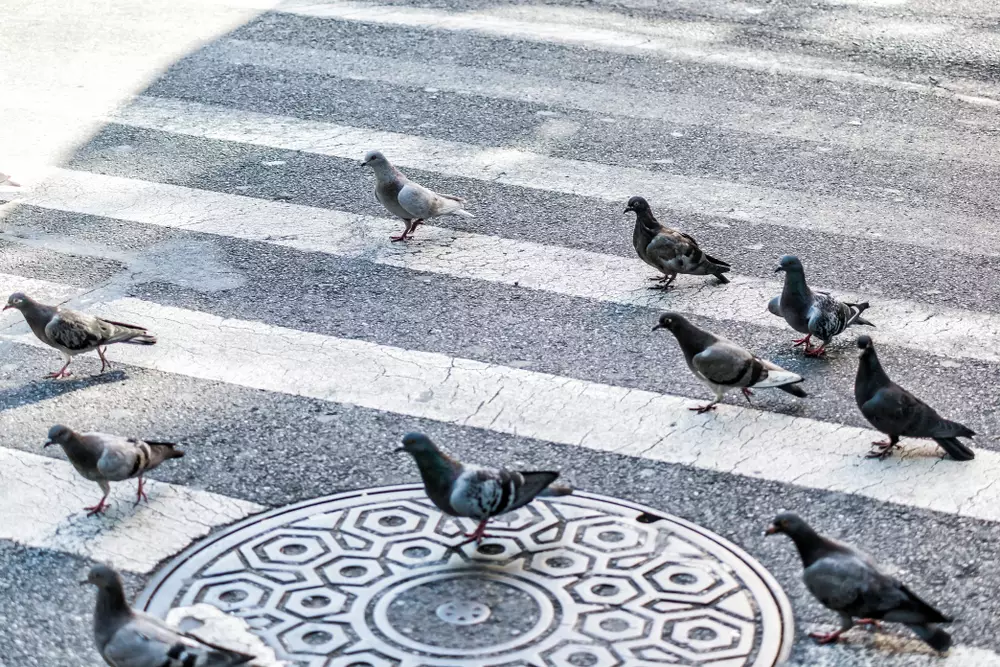Pigeons, our feathered neighbors, are seen almost everywhere, from city squares to rural barns. We often see them fluttering across busy streets, seemingly unbothered by the hustle and bustle of city life. This regular road-crossing behavior of pigeons might leave many of us pondering, particularly about the reasons and implications behind these actions.
Pigeons cross roads for reasons ranging from searching for food and shelter to marking territory and evading predators. These diverse motivations are rooted in their adaptability to urban environments, influenced by human activities and population density.
Road-crossing pigeons are not just trivial city phenomena but part of the intricate relationship between humans and urban wildlife. Our actions can significantly influence pigeon behaviors, including their frequent traversing of busy roads.
Pigeon Habitat and Natural Environment
Urban Pigeons versus Rural Pigeons
Pigeons are incredibly versatile and resilient creatures, flourishing in various environments worldwide. Urban pigeons, often recognized as city doves or street pigeons, have adapted to thrive in densely populated areas. They’ve learned to forage for food and build nests in high-rise buildings, much like their ancestors would do on rocky cliffs.
Rural pigeons, on the other hand, often inhabit farmlands, barns, and open fields. While their city cousins frequently cross roads, rural pigeons tend to stay within their preferred habitats, making road-crossing an infrequent behavior for them.
Adaptation to Human Environments
Pigeons have an incredible ability to adapt to human environments. They’ve learned to navigate the cityscapes and human-made structures, effortlessly flying between buildings and even crossing roads when necessary. This adaptation extends to their feeding habits as well, scavenging on food waste, thus becoming an integral part of urban ecosystems.
Why Pigeons Cross Roads
Searching for Food
Pigeons primarily cross roads in their quest for sustenance. Cities, with their abundance of food waste, offer an attractive proposition to pigeons, who take advantage of every available food source.
Searching for Shelter
Shelter is another reason why pigeons might cross roads. Pigeons often nest in high places like ledges, eaves, and loft spaces. The other side of the road might provide a safer nesting spot, encouraging pigeons to make the journey.
Evading Predators
Pigeons are often the target of urban predators such as cats, hawks, or even other larger birds. Crossing the road might serve as an escape route when under threat.
Like many other bird species, pigeons have a strong sense of territory. They use familiar routes to navigate their surroundings, which sometimes include crossing roads to reach different parts of their domain.

Human Impact on Pigeon Behavior
Urbanization and Pigeon Population
The expansion of cities has inadvertently provided an abundance of food and shelter for pigeons. The more we build and the more food waste we produce, the more pigeons are attracted to urban environments. Thus, urbanization indirectly encourages road-crossing behavior among pigeons.
Feeding Pigeons: Pros and Cons
Feeding pigeons can be a double-edged sword. While it provides them with an easy source of nutrition, it can also contribute to overpopulation and health issues, both for pigeons and humans. It can also reinforce their road-crossing behavior as they start associating certain areas with food availability.
Pigeon Road Crossings and Traffic Accidents
Risks Pigeons Face in Traffic
Despite their apparent casualness when crossing roads, pigeons face considerable risks. Traffic accidents involving pigeons can result in fatalities for the birds and disrupt traffic flow, leading to further accidents.
Impact of Pigeon Road Crossings on Traffic
Pigeons crossing roads can cause drivers to swerve or stop suddenly, leading to potential traffic accidents. Additionally, large flocks of pigeons can obstruct visibility and impede the flow of traffic.
Pigeon Safety Measures
Measures to Protect Pigeons in Urban Areas
Various measures can be implemented to protect pigeons in urban areas. These include creating safe feeding zones away from busy roads, educating the public about responsible feeding practices, and designing bird-friendly urban environments.
Effective Urban Planning for Bird Safety
Urban planning plays a critical role in safeguarding urban wildlife, including pigeons. Incorporating bird-friendly elements into city designs, such as green roofs and safe nesting places, can create a safer environment for our feathered friends.
Frequently Asked Questions
Why do pigeons seem unafraid of cars?
Pigeons have remarkable adaptability and can acclimate to human activity, including moving vehicles. However, this doesn’t mean they are immune to the dangers of traffic.
Are pigeons affected by pollution?
Like all urban wildlife, pigeons are indeed affected by pollution. Air, noise, and light pollution can impact their health and behavior, including their road-crossing activities.
How can we reduce the impact of road-crossing pigeons on traffic?
One way is to create safe feeding zones away from busy roads. Educating the public about responsible feeding practices can also help to direct pigeons away from dangerous areas.
Conclusion
The frequent sight of pigeons crossing roads is a testament to their adaptability in urban environments. Understanding why pigeons cross the road provides insights into their behavior, survival strategies, and the impacts of urbanization on their lifestyles.
Our actions can significantly influence these behaviors, shaping the way pigeons interact with their urban surroundings. As city dwellers, it is essential to consider our shared responsibility in creating safe habitats for these birds.
The human-pigeon relationship is a delicate balance. As we continue to build and expand our cities, it is crucial to consider the impacts on urban wildlife. Ensuring the safety of pigeons crossing the road is not just about protecting the birds; it is also about safeguarding our urban ecosystems.